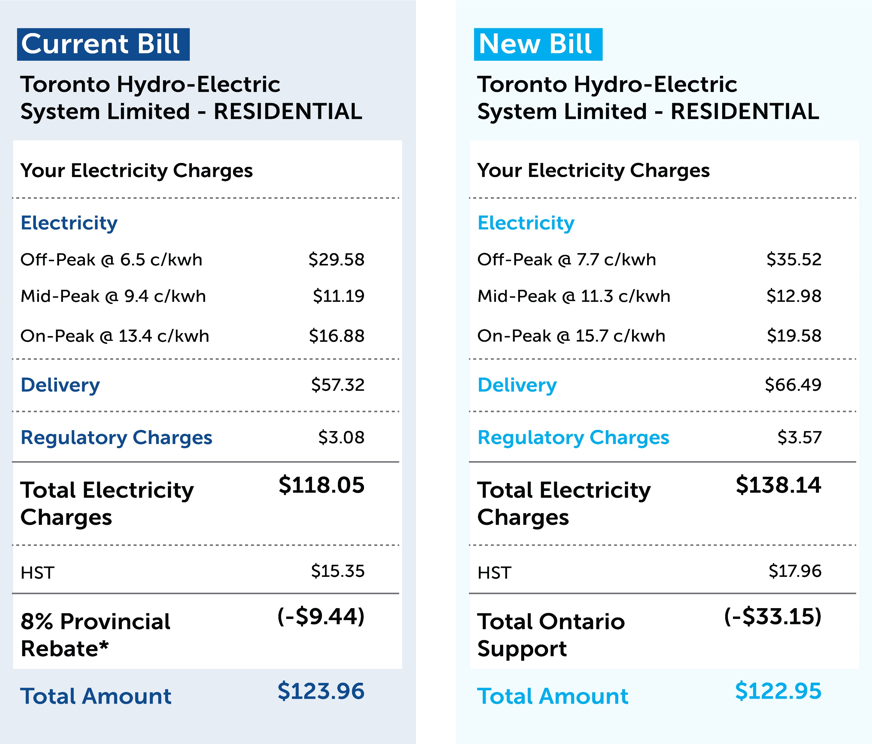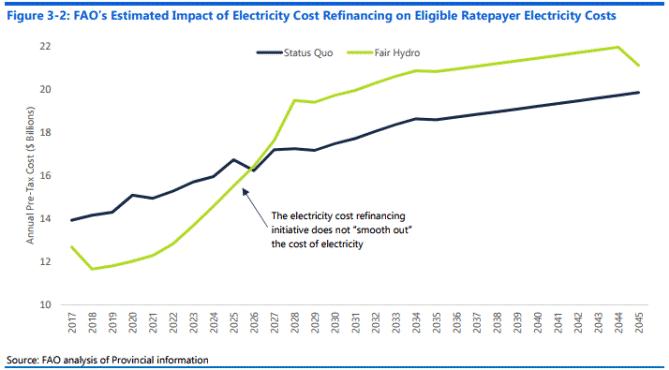Can the Province Get Electricity Rates Down by 12% – Option 1: Convince People it’s Already Done?
The StrategyCorp Institute of Public Policy and Economy will be producing a series of articles to explore the government’s options to achieve government’s stated electricity goals, including the 12% electricity savings for residential consumers promised. Part one will examine the political context around electricity and how we got here.
Starting as soon as November 1, 2019, the Ford government plans to change electricity bills to include a new line item called the “Total Ontario Support” message. According to a regulation posted for comment by the Ministry of Energy, the new Total Ontario Support line will be the combination of all government supports, totaling the roughly 25% discount provided through the Fair Hydro Plan.[1] Though the new line item will look like new savings to consumers, it will be the same subsidy previously provided.

The Background
When electricity was the only issue that mattered at Queen’s Park, the provincial Tories hammered the then governing Kathleen Wynne Liberals on the issue at every possible opportunity. Eventually, the Liberals created an off-book refinancing scheme known as the Fair Hydro Plan to reduce hydro rates by 25%. When the program came into force in the Summer of 2017 it achieved its goal of reducing the overall cost.
However, when Ontarians look at their hydro bill, the benefits are hard to decipher since the Fair Hydro Plan savings are embedded within the cost of electricity. Essentially, people may realize that their overall bill is cheaper, but they cannot see why. Further, nothing really credits the government for the $45 billion they are spending to provide the reduction.[2]
Moreover, the Progressive Conservatives promised an additional 12% reduction on bills in the 2018 election. Now, nearly a year and a half into their mandate, they have yet to make a demonstrable impact on Ontarians’ hydro bills.

The Context
Even though the Fair Hydro Plan reduced bills by 25%, voters very much still cared about electricity prices approaching the 2018 election. Just one week before the election date, Ipsos showed that hydro prices were affecting the ballot choice of 61% of Ontarians and that only 22% had even noticed a reduction in their bill.[4] Since then, electricity has fallen off the map in favour of issues like budget cuts and health care and the popularity of the PCs has fallen, with only 26% approving of Premier Doug Ford.[5]
Even more important, the 12% reduction was made up of 4 individual policies. Three of those policies – a moratorium on new contracts, cancelling conservation programs, and cancelling more than 700 planned generation contracts – have already been implemented but bills have not been visibly reduced with most savings coming in the form of cost avoidance. The government has only identified one other policy lever – returning the Hydro One dividend to ratepayers – but that won’t deliver the 12% savings promised on its own. This begs an important question, how can they even achieve the 12% reduction and, if not, does it matter?
Convincing People You’ve Already Done It
When the Fair Hydro Plan came into force, only the HST reduction was broken out as a separate line item on bills, with the remaining 17% of the savings being embedded within the cents per kilowatt hour cost of electricity. By breaking out a new Total Ontario Support line item, Ontarians will clearly see the savings provided by the government in addition to the true cost of electricity. Logically, the government is arguing that Ontarians should know how much the government is saving them, but they should also know how expensive electricity really is.
There is, however, another consequence of the move. If the average Ontarian did not realize their bill was being massively subsidized, which polling indicates is the case, then showing a new government subsidy line on bills may give the appearance that the savings themselves are new. Car companies do it all the time. Buying a new truck and getting $1,000 back is better than just reducing the price of the truck by $1,000. There is a chance that Ontario families credit the Ford government with implementing the new savings.
It is worth remembering, if people believe their bill has been reduced by 12% or more, than the promise is essentially accomplished. The government could then re-evaluate the other decisions it would need to make to achieve the 12% additional reduction in bills, such as promising to spend roughly $400 million a year on a Hydro One rebate to customers.[6] At the very least, the government would have the time it needs to make legitimate and systemic fixes to a system in dire need of repair.
What Next?
Up until this change, the Ford government has been quite public about its desire to achieve the 12% bill reduction. Either the bill change will convince Ontarians that the electricity system is under control, buying the government more time to make important decisions, or the changes will have no impact and force the government to act even sooner. Regardless, important changes affecting the electricity sector will be made over the rest of the government’s mandate. If nothing is done, the Fair Hydro Plan will expire in 2021, right before the next election. Therefore, doing nothing is not an option.
Part two of our series will evaluate options to achieve the 12% reduction, beginning with a look at the future of capacity markets and renegotiating generation contracts. Future articles will look at options to reform low-income programs, further update the Ontario Energy Board, and the state of industrial electricity programs in Ontario.
[1] https://www.ontariocanada.com/registry/view.do?postingId=29987&language=en
[2] http://www.auditor.on.ca/en/content/specialreports/specialreports/FairHydroPlan_en.pdf page 20.
[3] https://www.fao-on.org/en/Blog/Publications/Fair_hydro
[4] https://www.ipsos.com/en-ca/news-polls/Global-News-Ontario-Vote-Hydro-Poll-May-29-2018
[5] https://toronto.citynews.ca/2019/09/19/provincial-leaders-poll-september-2019/
